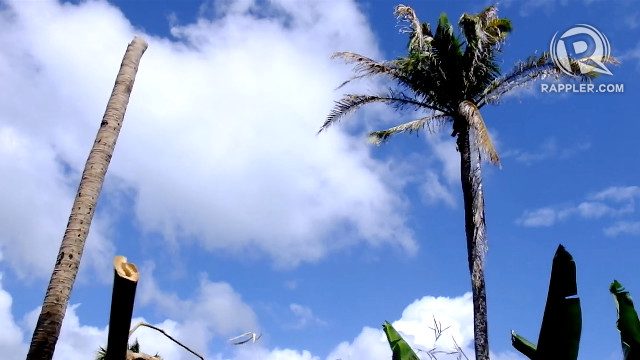SUMMARY
This is AI generated summarization, which may have errors. For context, always refer to the full article.

MANILA, Philippines – The government is confident that the formidable coconut scale insects that have infested over two million trees in Calabarzon (Region IV-A) and Mindanao will be “manageable” by December, the deadline they set.
“It’s very likely that we will meet the December deadline. The pest has been significantly reduced also because of the effect of the weather, of [Typhoon] Glenda. And also because of the pruning and our treatments of systemic pesticide,” Philippine Coconut Authority Administrator Romulo Arancon Jr told Rappler on Monday, September 29.
He said Glenda’s strong winds and rain last July reduced the population of pest called Aspidiotus rigidus.
Following a protocol created to keep the pest’s spread in check, a government task force, with the help of volunteer coconut farmers, has been pruning out infested trees or felling severely infested trees.
Meanwhile, PCA personnel have been injecting into tree trunks a “systemic pesticide” called Dinotefuran meant to kill off pests to arrest their spread.
The measures have proven effective, said Arancon.
Based on initial findings by a team of on-the-ground assessors, the two million infested trees are now recovering as indicated by the greening of their leaves which had previously been yellow, a sign of infestation, he told Rappler. (READ: PH to lose P186M a year from coconut pest outbreak)
He admitted these indicators were still “visual,” but the assessment team is gathering more scientific indicators such as the number of pests per tree, to get a more accurate picture of the situation.
The pest will never be 100% eradicated but, he said they “are looking at a manageable level and a balanced ecosystem.”
Meanwhile, strict quarantine measures will be maintained. Arancon said there are 23 quarantine checkpoints in infected provinces to prevent the transport of infested coconut seedlings, coconuts, and other crops.
Pesticide problems
The PCA has come under fire for its use of the pesticide Dinotefuran, a type of neonicotinoid condemned by environmentalists because of its toxicity to insects like honeybees and silkworms.
Greenpeace Philippines cited a report by the International Union for the Conservation of Nature (IUCN) that says neonicotinoids also affect aquatic insects, earthworms and even birds.
“Maybe instead of solving cocolisap (coconut scale insect), we are inviting more problems with the poisoning of our environment,” said Greenpeace Philippines Campaigner for Sustainable Agriculture Daniel Ocampo.
Neonicotinoids like Dinotefuran kill insects by attacking the nervous systems of insects. They are the most commonly used type of agricultural pesticide worldwide.
While not denying the effect of Dinotefuran on these insects, Arancon said the pesticide is Category 4 in toxicity, meaning it is the least toxic and least persistent of its kind. The most toxic pesticides are put under Category 1.
He said the chemical, approved by the Fertilizer and Pesticide Authority, has “very low mammalian toxicity,” meaning it is relatively benign to humans.
And while the use of Dinotefuran may save the coconut trees and kill such ecologically and economically valuable insects such as honeybees, some scientists say it’s a manageable trade-off.
A well-managed application of Dinotefuran will be able to contain its use only in severely infested areas, said Coalition for Agricultural Modernization in the Philippines chairman Emil Javier in an opinion piece for the Philippine Daily Inquirer
“The damage will not be permanent because the honeybee population in nearby untreated areas will recolonize the outbreak areas,” he added.
More than 330,000 coconut farmers in Calabarzon are affected by the scale insect outbreak. Also affected are the thousands who make a living from other coconut-derived products like cooking oil, livestock feeds, ropes, blankets, vinegar, handicrafts, and furniture.
The Calabarzon coconut industry is the largest in Luzon, producing more than 1.5 million coconuts in 2006. That accounts for almost half (42%) of Luzon’s total coconut production. – Rappler.com
Add a comment
How does this make you feel?
There are no comments yet. Add your comment to start the conversation.